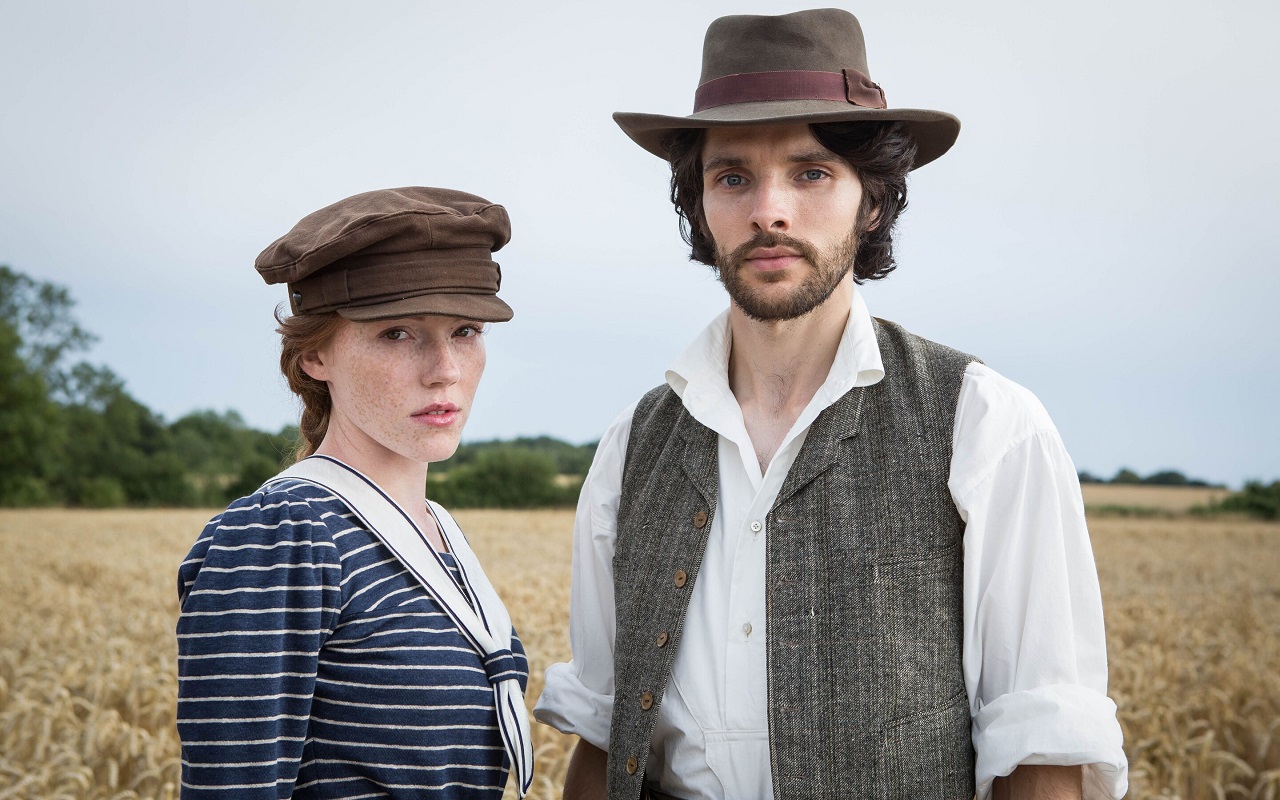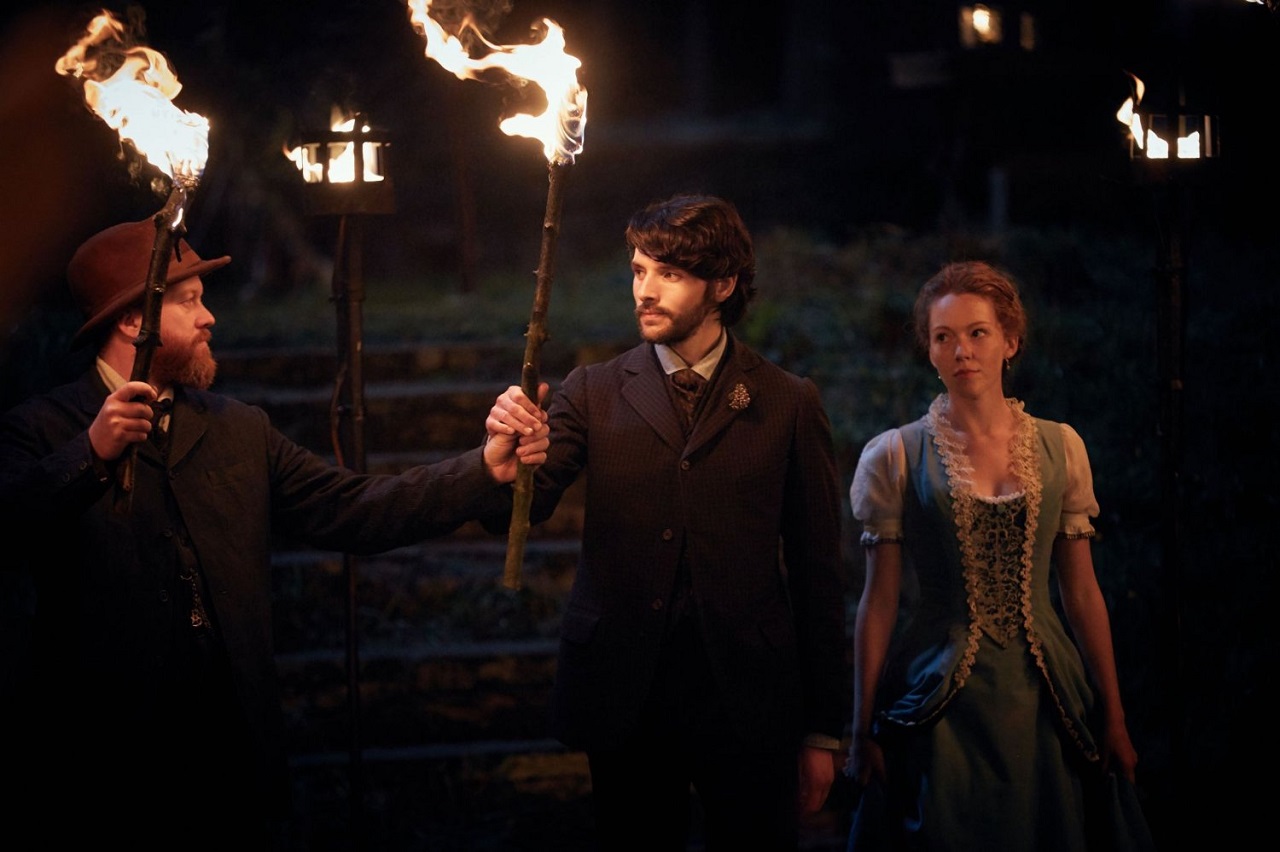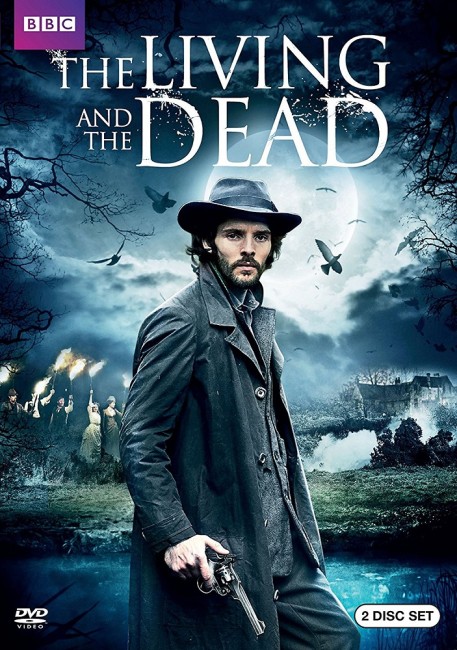UK. 2016.
Crew
Directors – (Episode 1-3) Alice Troughton & (Episode 4-6) Sam Donovan, Teleplay – (Episode 1&2) Ashley Pharaoh, (Episode 3&6) Simon Tyrrell, (Episode 4) Robert Murphy & (Episode 5) Peter McKenna, Created by Ashley Pharaoh, Producer – Eliza Mellor, Photography (Episode 1-3) – Matt Gray & (Episode 4-6) Suzie Lavelle, Music – The Insects, Visual Effects – Lexhag Ltd, Special Effects Supervisor – Tom Harris, Production Design – Pat Campbell. Production Company – BBC/Monastic Productions/BBC America.
Cast
Colin Morgan (Nathan Appleby), Charlotte Spencer (Charlotte Appleby), Nicholas Woodeson (Matthew Denning), Malcolm Storrey (Gideon Langtree), Kerrie Hayes (Gwen Pearce), Tallulah Haddon (Harriet Denning), Chloe Pirrie (Lara), Joel Gilman (Jack Langtree), Fiona O’Shaughnessy (Martha Enderby), Isaac Andrews (Charlie Thatcher), Robert Emms (Peter Hare), David Oakes (William Payne), Elizabeth Berrington (Maud Hare), Pooky Quesnel (Agnes Thatcher), Steve Oram (John Roebuck), Arthur Bateman (Gabriel Appleby), Gina Bramhill (Alice Wharton), Marianna Oldham (Mary Denning), Harry Peacock (Smith), Diana Quick (Sylvia), Royce Pierreson (Ben), Joanna David (Victoria Appleby), Katy Carmichael (Clarity Winlove)
Plot
Shepzoy, Somerset, 1894. Nathan Appleby and his wife Charlotte have moved back to the family home from London. With the death of his mother not long after they move in, Nathan inherits the estate. He and Charlotte are optimistic about reviving the farm’s finances and Nathan wants to bring a railway to the area. After the overseer kills himself, Charlotte decides to manage the farm. However, she causes fear among the local workers about layoffs when she buys a traction engine. Nathan and Charlotte are grieving the death of their son Gabriel who accidentally drowned and are cautiously trying to have another child. Nathan has trained as a psychologist and is asked by the local vicar Matthew Denning to help with his daughter Harriet, who claims to be haunted and starts manifesting the voice of a dead man. In trying to aid her, Nathan sees a vision of a woman holding a book of light. Nathan tries to understand an increasing number of apparitions around the farm and turns to communicating with the dead, while the locals believe the land is cursed. As Nathan sees the possibilities of being reunited with Gabriel, his obsession begins to have an effect and cause ruin to everything around him.
The Living and the Dead was a Mini-Series made for the BBC in six one-hour episodes. It is a work where the BBC have lavished the considerable resources at their disposal to create a richly detailed period setting, all set in a sumptuously photographed rural countryside that is transformed into a dreamy fantasy of rural Victorian England.
The modern Ghost Story has become a genre where it feels that so many films throughout the 2000s/2010s have recycled the tropes and possibilities that it has little that is new to recommend it. Despite my misgivings about the over-familiarity of the genre, The Living and the Dead is one of the most unique and original variants we have had in some time.
The series was the creation of Ashley Pharaoh who started out in the 1990s as a writer on British tv series such as Casualty (1985- ) and Eastenders (1985-2002). Pharaoh went on to create shows such as Down to Earth (2000-5), Paradise Heights (2002), Bonekickers (2008) and Wild at Heart (2006-13), although is perhaps best remembered as the creator of Life on Mars (2006-7) and Ashes to Ashes (2008-9) in which detectives inexplicably wake up back in the 1970s and 1980s. In genre-related material, he also created the short-lived Eternal Law (2012) about angels and more recently the David Tennant-starring mini-series version of Jules Verne’s Around the World in 80 Days (2021).
The Living and the Dead is a depiction of a Victorian Gaslight Setting that sits on the cusp of social change. Colin Morgan’s Nathan returns to rural Somerset, an advocate and practitioner in the new field of psychology, while seeking to bring a branch of the train line to the area. There is the theme that runs through several episodes of the newly introduced traction engine, which it is hoped will revolutionise farming, but promptly becomes a symbol of fear to the locals who believe it will bring unemployment and an end to their traditional ways. (This gets a shocking twist placed on it when overseer Steve Oram goes out into the field and uses an apple to lure a horse to come to him and then lies down in the path of the plough and lets it slit his throat). Nathan also has a speech about how the social uncertainty is turning people to things like spiritualism, although for all his modernising ways this is exactly what ends up happening to him by the end of the series.

This encroaching edge of modernity sits alongside an element where it is clear the old folk religion is still alive and being practiced. The locals hold harvest festivals; Kerrie Hayes’s maid practices home remedies including tying a piece of cloth with menstrual blood on it to a tree to determine if Charlotte Spencer is pregnant; Charlotte takes photographs of the locals dressed in ritual masks. In Episode 3, we also see the fear of witches has not left this corner of the world either. It feels like the depiction of a whole disappeared and forgotten corner of rural England and the ways of the people of the land. It is not exactly Folk Horror territory, as the elements are played in a naturalistic as opposed to sinister and threatening way, but certainly overlaps the genre.
The show makes a striking balance between these two ways. Its’ hero is an advocate of modern science but throughout the course of the show his arc is to increasingly abandon that and accept belief in ghosts and the necessity of exorcism. At times the balance is quite sophisticated – in Episode 3, we see the appearance of ghosts at the same time as Colin Morgan is advocating science and debunking the notion of witches, calling them just ordinary people using folk remedies.
The show has both an overarching ghost story, while at the same time follows an episodic format where each of the first five episodes has a self-contained story about one of the locals experiencing some manifestation of the supernatural. All of these stories are strong and well worthwhile. The second episode comes with the heart-wrenching story of the mining disaster and arrives at a saddening fate, before ending on the beautiful image of the dead boy skipping across the field with the ghosts of the children from the mine. Episode 4 comes with a wonderfully haunted performance from Fiona O’Shaughnessy.
However, it is Episode 5 that becomes the standout. Things get particularly haunted with visions of bodies hanging from trees; Tallulah Haddon found hanging, while levitated in mid-air in the church; the appearance of the dead son in the photo and his voice coming out of the wax cylinder recording device; and especially with the appearances of the ghostly Civil War soldiers in the woods. This episode gets particularly dark, never more so than when Colin Morgan abruptly cancels the exorcism upon the realisation that it will mean never seeing his beloved son again. Or how by the end of the episode, we see just how much his obsession is affecting everyone around him and the entire township.

And then there are the eerie anachronistic touches. Like when Colin Morgan hears the noise of a jet and looks up to see a contrail in the sky but thinks nothing of it – which becomes jarringly anachronistic to us because we recognise what it is. And then there comes the superbly eerie end to Episode 1 where Colin Morgan sees Chloe Pirrie standing at the end of a hallway holding is a modern tablet (what he refers to as ‘the book of light’). At another point, we see the lights of a car coming down a lane and later lights appearing outside the window and a car pulling up. This is the novel idea of a ghost story where the ghosts are not so much the past reaching up to the present (although there is plenty of those) but visions someone is receiving of the future.
Things all come together in the final episode, which weaves together the past and present in striking ways and all of the touches throughout finally start to make sense. Even then, the show reaches an ending that manages to hold some surprises. Not to mention the slingshot ending for the never-made second series where Colin Morgan is called downstairs by a 1920s era séance being held where the jolting last line of the series is them asking “Nathan Appleby, why did you kill your wife?”
The two leads are superbly cast. Colin Morgan, previously the title character in tv’s Merlin (2008-12), has a commanding presence, while Charlotte Spencer sparkles with a natural vivacity and is written with a proto-feminist surety that was well ahead of her era. In the scenes of the two of them very much in love in the early episodes, it feels a wonderfully fresh and alive relationship.
(Winner in this site’s Top 10 Films of 2016 list. Nominee for Best Original Screenplay and Best Actress (Charlotte Spencer) at this site’s Best of 2016 Awards).
Trailer here


